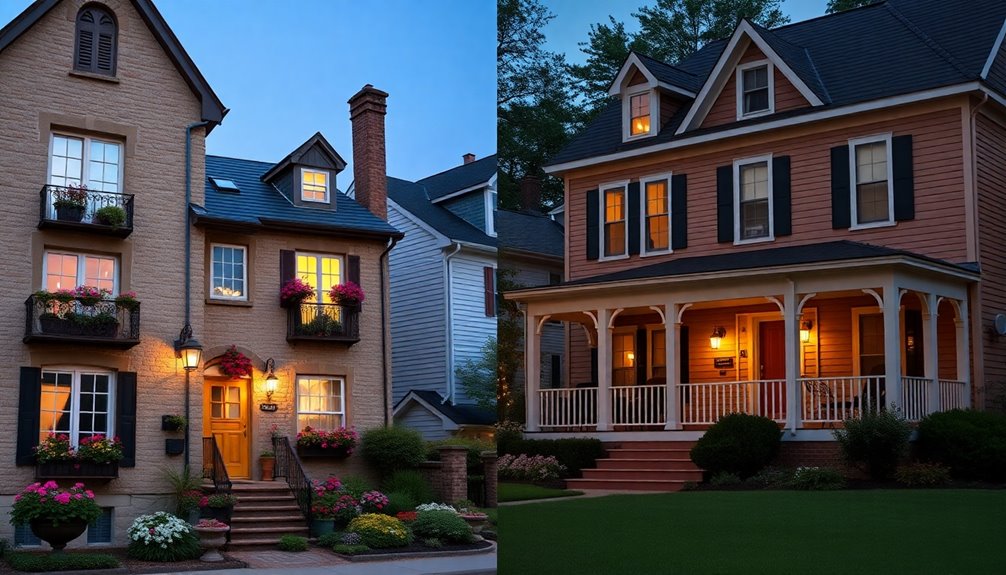When comparing European and American homes, you'll notice some key differences. European homes typically feature compact, defined spaces that maximize function and privacy. In contrast, American homes often have open floor plans that encourage social interaction. Materials also vary: Europeans prefer durable stone and concrete, while Americans lean towards lighter wood. Kitchen sizes reflect these styles too; Europeans opt for smaller appliances, while Americans embrace larger ones. Finally, European homes often utilize sustainable heating methods and energy-efficient designs. If you want to uncover even more interesting contrasts, there's plenty more to explore.
Key Takeaways
- European homes typically feature compact, separate rooms, while American homes favor open floor plans for social interaction and spaciousness.
- Construction materials differ, with Europeans using sturdy stone and concrete, whereas Americans often opt for lightweight wood and plaster.
- European kitchens prioritize energy efficiency with smaller appliances and induction stovetops, while American kitchens emphasize larger appliances and decorative elements.
- Heating systems vary, as Europeans often use renewable sources like heat pumps, while Americans predominantly rely on gas heating systems.
- Solar energy adoption is more prevalent in Europe, reflecting a commitment to sustainability, in contrast to American homes which focus more on privacy and larger lots.
Major Design Differences
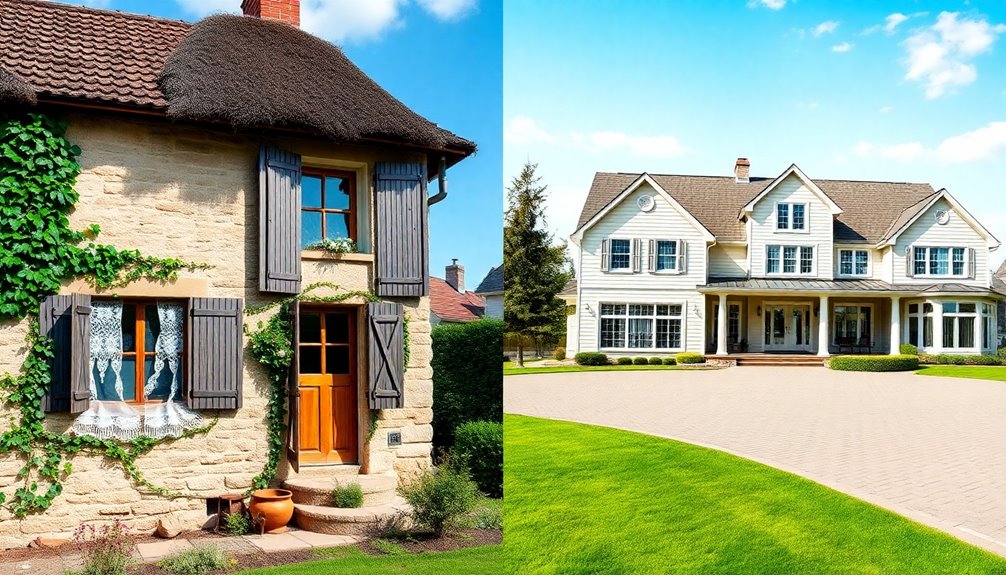
When you compare European and American homes, you'll quickly notice significant design differences that reflect cultural preferences.
European homes typically feature compact, separate rooms dedicated to specific functions, while American homes emphasize open floor plans, merging living, dining, and kitchen areas for a more spacious feel. The
Construction Materials Used

When you compare construction materials in American and European homes, you'll notice significant differences in durability, style, and function.
Americans often use lightweight materials like wood and plaster, while Europeans lean toward sturdy stone and concrete for long-lasting structures.
These choices extend to roof styles and flooring, reflecting each region's unique preferences and environmental considerations.
Material Durability Comparison
European homes are often built with durable materials like stone and brick, which offer superior insulation and longevity compared to the lightweight wood and plaster typical in American construction.
The thicker walls found in European homes enhance material durability and energy efficiency, reducing your energy costs over time. In contrast, American homes usually feature thinner walls, which can lead to higher heating and cooling expenses.
Additionally, while Europeans prefer robust roofs made from wood or rigid tiles, American homes typically opt for shingle roofs, requiring more frequent replacements.
This choice in construction materials reflects a focus on durability and energy efficiency in Europe, while American homes often prioritize cost-effective, lightweight options.
Roof Style Preferences
Roof style preferences reveal significant differences between American and European homes, particularly in the materials used.
In the U.S., you'll often find asphalt shingles, which are lightweight and cost-effective, focusing on quick installation. In contrast, European homes typically use clay tiles or wooden roofs, known for their excellent insulation and construction durability. These materials can last over 50 years, providing better protection against the elements.
Additionally, European roofs tend to feature steeper pitches to aid in rain runoff and snow accumulation. Climate considerations further influence these choices, with heavier materials like slate being favored in Europe to withstand harsher weather, while American homes generally lean towards lighter roofing materials for ease of maintenance and energy efficiency.
Flooring Choices Differences
While both regions share a love for natural wooden flooring, the choices in materials and styles reveal distinct differences in American and European homes.
- Material Preference: European homes often showcase stone or marble floors for durability, while American homes lean towards tiled floors for practicality.
- Wood Types: Europeans typically prefer natural wooden flooring for warmth, whereas Americans opt for laminate and engineered wood for cost-effectiveness.
- Insulation: Thicker flooring in European homes enhances insulation and noise reduction, contrasting with the lighter options seen in American houses.
In kitchens, Europeans choose elegant stone or high-quality tiles, while Americans tend to favor affordable vinyl or laminate.
These flooring choices reflect deeper cultural values in both regions.
Kitchen Features Comparison
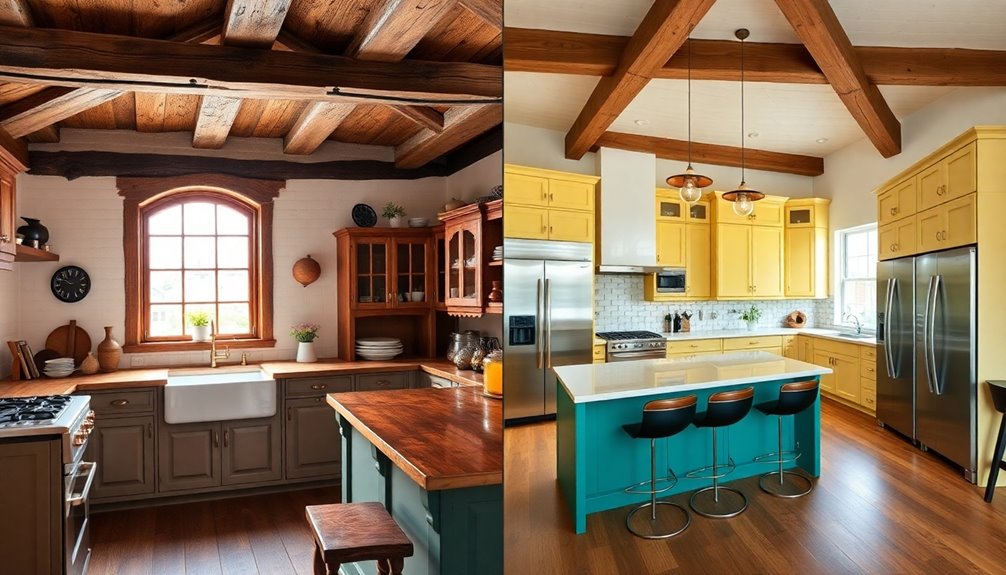
When comparing kitchen features, you'll notice distinct differences between European and American styles.
European homes often showcase traditional solid wood cabinets, emphasizing durability and aesthetics, while American kitchens frequently highlight appliances as part of the décor.
Induction stovetops dominate in Europe, reflecting a trend toward energy efficiency, whereas gas stoves are more common in the U.S.
You'll also find that European kitchens typically have smaller refrigerators since residents shop more frequently.
Regarding design, Europeans prefer hidden appliances for a minimalist look, while Americans like their appliances on display.
Finally, flooring choices differ, with European homes favoring stone or marble for their durability, contrasting with the tiled floors commonly found in American kitchens.
Home Size Statistics
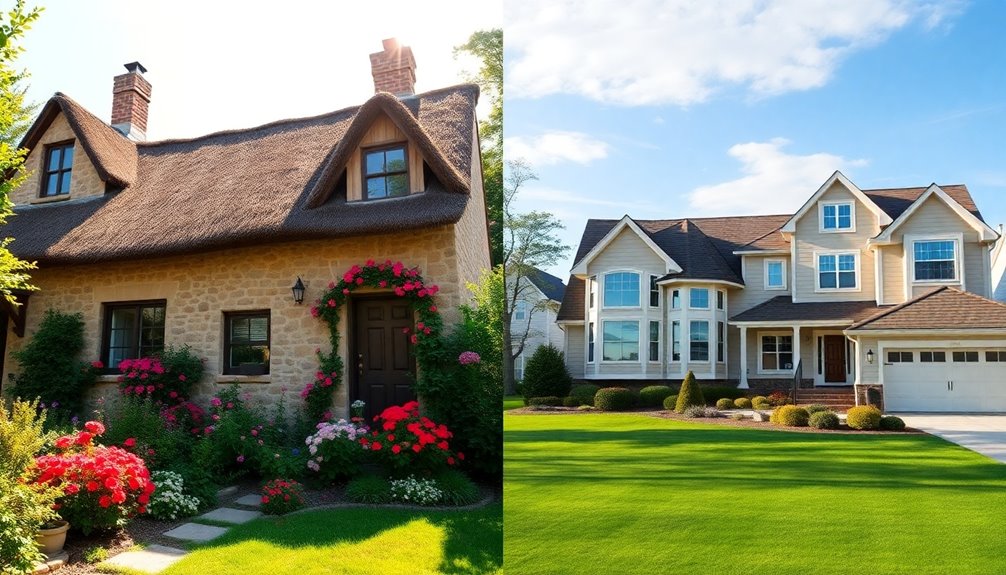
Understanding kitchen features sets the stage for appreciating broader differences in European and American homes, particularly in size.
Home size statistics show a stark contrast:
- The average American home is about 2,407 square feet, while European homes are smaller, averaging 1,000 to 1,300 square feet.
- Overall, the average home size in the U.S. is 4,982 square feet compared to just 1,589 square feet in Europe.
- Urban density in Europe promotes energy-efficient, compact living spaces, emphasizing communal living over individual properties.
While American homes often boast multiple bedrooms and private outdoor spaces, European homes focus on functionality and efficiency within smaller footprints.
This difference reflects distinct lifestyle preferences between the two regions.
Heating Methods Explained

When it comes to heating methods, European homes often rely on radiant heating systems that provide cozy warmth.
You're likely to notice a growing trend in solar energy adoption, as many homeowners seek sustainable solutions.
Plus, in northern Europe, air conditioning isn't as common, but that's changing with the rise in temperatures.
Radiant Heating Systems
Radiant heating systems are becoming increasingly popular for their ability to deliver consistent warmth throughout a home.
In European homes, these systems often provide efficient heating and are designed to minimize temperature fluctuations.
Here's how they differ from American homes:
- Installation: European homes frequently use wall-mounted or floor heating systems, enhancing comfort and aligning with energy-efficient designs.
- Energy Sources: While both regions use gas heating, European homes are adopting electric heat pumps as a sustainable alternative.
- Hot Water Heaters: European homes typically feature smaller hot water heaters, unlike the larger units common in American homes to meet greater demands.
These differences highlight the efficiency and comfort radiant heating systems can bring to your living space.
Solar Energy Adoption
As energy efficiency becomes a priority in home design, solar energy adoption is gaining momentum in Europe. You'll find that many European homes incorporate solar roof systems, which enhance energy efficiency and reduce reliance on fossil fuels. Unlike American homes that often depend on gas heating, European homes are increasingly turning to renewable energy sources like solar energy. This shift not only promotes sustainability but also lowers utility costs. In regions with high energy costs, electric heat pumps paired with solar energy provide a sustainable heating solution. While air conditioning is less common in cooler climates, the trend is shifting as summers warm up, leading to interest in solar-powered cooling options. Additionally, the integration of AI security in energy management systems can further optimize energy consumption and enhance the overall efficiency of solar installations.
Air Conditioning Trends
While many American homes rely on central air conditioning to maintain comfort during hot summers, European homes often take a different approach. They emphasize natural ventilation and energy-efficient designs, reducing the need for air conditioning.
Here are some key differences:
- Heating Systems: Northern Europe favors wall-mounted radiant heating or electric heat pumps, unlike the common gas heating systems in American homes.
- Building Design: European homes typically feature thicker walls and energy-efficient windows, helping to stabilize indoor temperatures.
- Solar Adoption: Solar roof systems are increasingly popular in Europe, allowing homeowners to reduce reliance on traditional air conditioning methods. Additionally, solar energy provides economic benefits through job creation in manufacturing, installation, and maintenance sectors.
These trends reflect a broader commitment to energy efficiency and sustainable living in European homes compared to their American counterparts.
Layout and Floor Plans
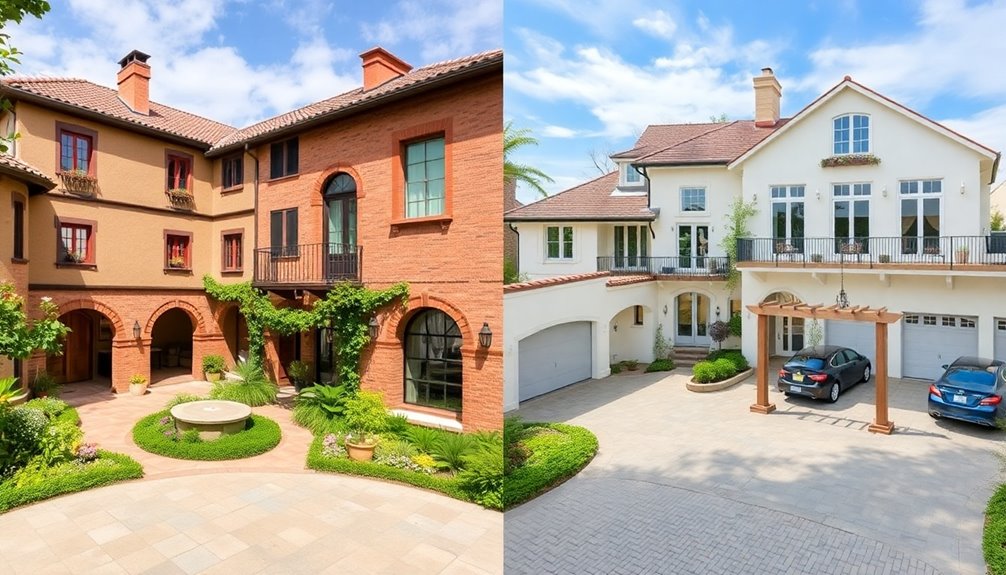
In comparing layouts, you'll find that American homes often embrace open, spacious designs that blend living, dining, and kitchen areas, creating a communal feel. In contrast, European homes typically feature more compact floor plans, with separate rooms for each function, fostering distinct living spaces.
| Feature | American Homes | European Homes |
|---|---|---|
| Layout | Open space | Separate rooms |
| Bedrooms | More (average 3) | Fewer (1-2) |
| Storage | Built-in closets | Freestanding wardrobes |
This difference in layout affects how you experience daily life. While American homes promote a social atmosphere, European designs emphasize privacy and function, adapting to various lifestyles.
Energy Efficiency Perspectives
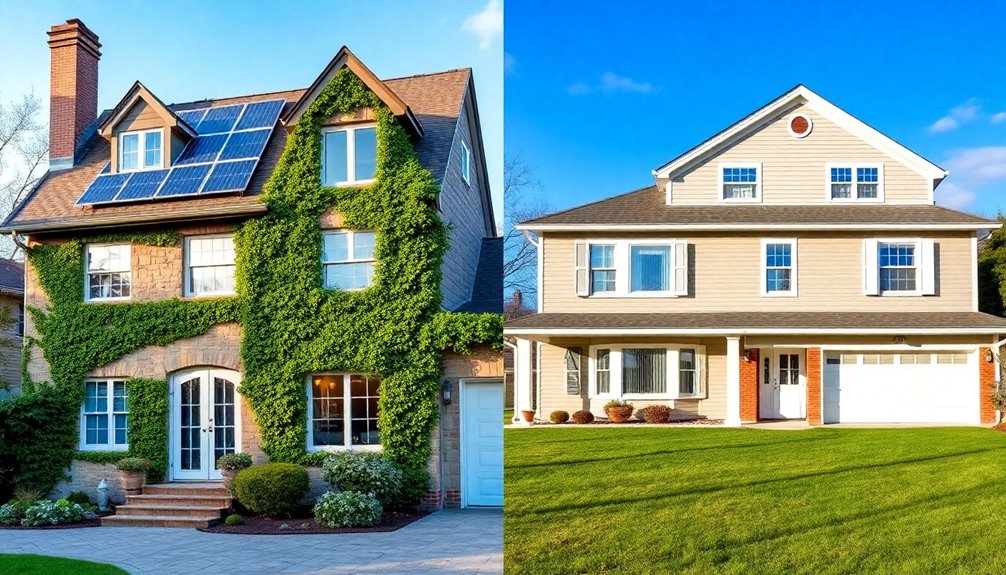
The differences in layout between American and European homes extend to their energy efficiency practices.
European homes typically prioritize energy efficiency, thanks to their compact design and superior insulation.
Here are some key differences:
- Insulation Quality: European homes use high-quality insulation and energy-efficient windows, while American homes often lack this focus.
- Cooling Methods: Many European homes don't rely on central air conditioning, opting for natural ventilation instead. In contrast, American homes, with their larger open spaces, struggle with temperature regulation.
- Energy Costs: Due to their size, American homes face higher energy costs, whereas European homes enjoy lower utility bills through sustainable building practices.
Cultural Influences on Design
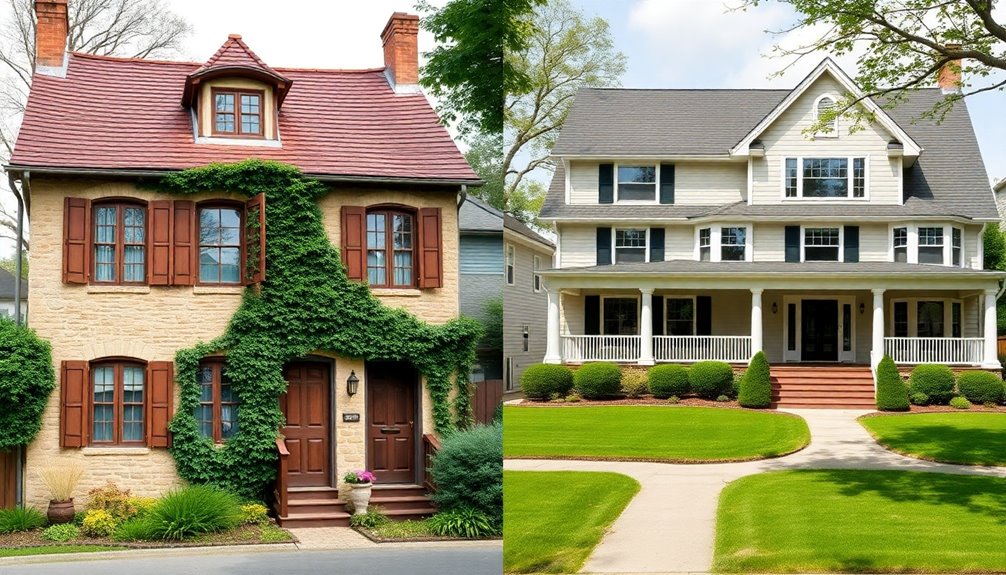
Cultural influences greatly shape home design, reflecting the values and traditions of each region. In European vs. American homes, you'll notice distinct differences.
European designs often draw from historical architecture, emphasizing timeless styles and craftsmanship that showcase local culture. In contrast, American homes embrace a blend of various architectural styles, resulting in an eclectic aesthetic.
The European community lifestyle promotes shared spaces, while American designs focus on privacy, leading to larger lots and gated communities. Additionally, sustainability is paramount in Europe, encouraging energy-efficient materials and practices, whereas American homes traditionally prioritize size and comfort.
This results in layouts that reflect communal living in compact spaces versus insular family-oriented areas in the U.S., ultimately influencing the overall home design.
Frequently Asked Questions
What Is the Difference Between American and European Houses?
When you compare American and European houses, you'll notice several differences.
American homes are generally larger, often featuring open floor plans that encourage social interaction. In contrast, European homes tend to be smaller, with distinct rooms for specific functions.
The construction materials also vary; Americans often use lighter materials, while Europeans favor sturdier options for better insulation.
Additionally, energy efficiency is prioritized in Europe, reflecting a commitment to sustainability and community living.
What Makes a House European Style?
Imagine sipping espresso in a cozy nook of your stylish European home.
A European-style house often features smaller, well-defined rooms, each serving a specific purpose. You'll appreciate sturdy materials like stone and wood, which not only provide durability but also better insulation.
Energy efficiency is key, with thick walls and efficient windows. You'll find traditional kitchens with solid wood cabinets, emphasizing functionality over space, creating an inviting atmosphere for culinary delights.
What Is a European Home?
A European home typically features compact living spaces, often ranging from 1,000 to 1,300 square feet.
You'll notice durable construction materials like stone and wood, which prioritize energy efficiency. Rooms serve distinct purposes, with kitchens and dining areas often separated.
Traditional kitchens emphasize solid wood cabinetry and smaller appliances, reflecting efficient use of space.
You'll also find a strong focus on energy-saving designs, including high-quality insulation and energy-efficient windows.
How Do European Houses Last so Long?
Think of a fortress standing tall against the test of time.
European houses last so long because they're built with heavy-duty materials like stone and concrete, creating strong foundations. Thicker walls provide excellent insulation, keeping your home comfortable year-round.
Clay tile roofs endure decades of weather, while energy-efficient triple-pane windows minimize heat loss.
Stricter building regulations guarantee these homes prioritize durability and sustainability, allowing them to withstand both time and nature's whims.
Conclusion
In conclusion, understanding the differences between European and American homes can feel like exploring a maze of cultural influences and design choices. From construction materials to heating methods, each style reflects the unique lifestyle and values of its region. Whether you prefer the cozy charm of a European abode or the spaciousness of an American home, both offer distinct advantages. Ultimately, your choice will depend on what resonates with you, much like selecting a favorite book from a well-stocked library.
